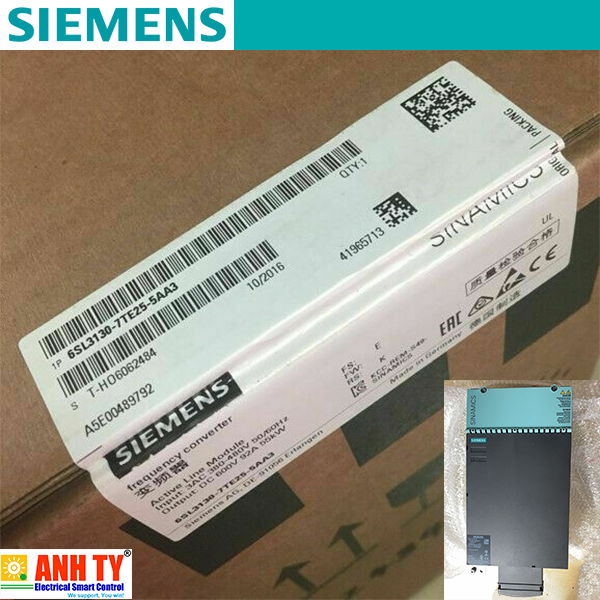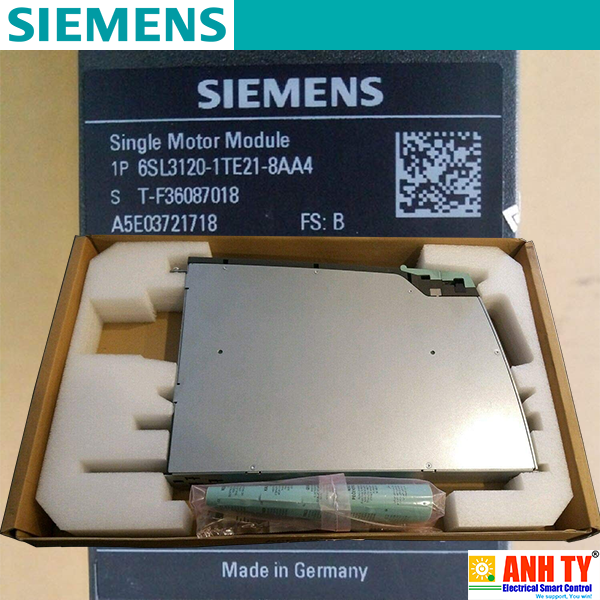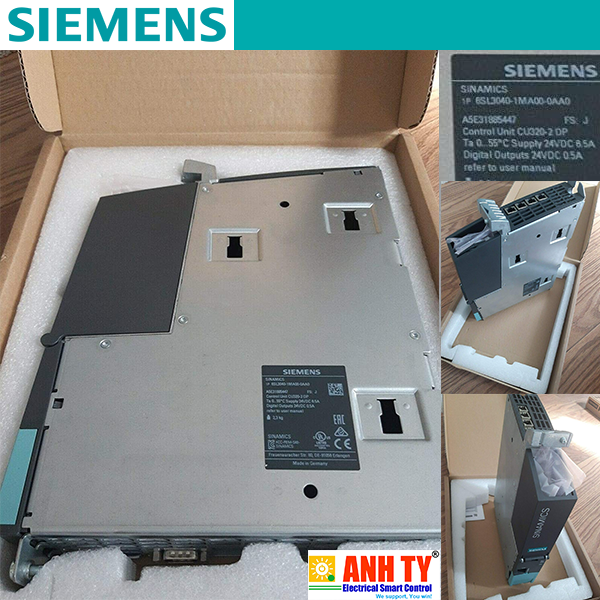



With its separate power unit and Control Unit, the SINAMICS S120 drive system can be perfectly adapted to a wide variety of different drive tasks.
The Control Unit is selected according to the number of drives to be controlled and the required performance level, while the power unit must be rated to meet the energy requirements of the system. The connection between the Control Unit and power unit is made very simply using the digital system interface DRIVE‑CLiQ.
CU310-2 PN Control Unit
CU320-2 PN Control Unit
CU310‑2 DP and CU310‑2 PN Control Units
The CU310‑2 Control Unit is used to control a single drive. A PROFIBUS interface (CU310‑2 DP) or a PROFINET interface (CU310‑2 PN) and a TTL/HTL encoder evaluation circuit are standard features.
CU320‑2 Control Unit
The CU320‑2 Control Unit is designed to control several drives. In this case, the following can be operated on a CU320‑2 Control Unit:
- Up to 12 drives in V/f control mode, orThe CU320‑2 Control Unit can be used to establish links between individual drives and to implement simple technological functions.
The simplest version of a SINAMICS S120 drive system comprises a CU310‑2 Control Unit and a Power Module. A line rectifier, a DC link and an inverter for supplying a motor are integrated in the Power Module.
Power Module in blocksize format with CU310‑2 Control Unit and BOP20 Basic Operator Panel
Power Modules are designed for single drives which are not capable of regenerating energy to the supply. Generated energy produced during braking is converted to heat via braking resistors.
Power Modules can also be operated via a CU320‑2 Control Unit, a SIMOTION D4x5‑2 or a CX32‑2 Controller Extension, for example, if a single drive is added to a multi-axis grouping. In this case, the Power Modules in blocksize format must be equipped with the CUA31/CUA32 Control Unit Adapter. This is connected via DRIVE‑CLiQ to the CU320‑2 Control Unit, the SIMOTION D4x5‑2 or the CX32‑2 Controller Extension. Power Modules in chassis format can be directly connected to the Control Unit using a DRIVE-CLiQ cable.
A DC link and an inverter for supplying a motor are integrated in the Motor Module.
CU320‑2 Control Unit, Line Module and three Motor Modules in booksize format
Motor Modules have been designed for multi-axis drives. Motor Modules are interconnected by means of a shared DC busbar. Since the Motor Modules share the same DC link, they can exchange energy with one another, i.e. if one Motor Module operating in the generator mode produces energy, the energy can be used by another Motor Module operating in the motor mode. The voltage-source DC link is supplied with mains voltage by a Line Module.
Line Modules generate a DC voltage from the line voltage and supply Motor Modules with energy via the voltage-source DC link.
Basic Line Modules
Basic Line Modules are designed only for infeed operation, i.e. they are not capable of recovering energy to the line supply. If regenerative energy is produced, e.g. when drives brake, it must be converted to heat by means of a Braking Module and a braking resistor. When a Basic Line Module is used as the infeed, the matching line reactor must be installed. A line filter can be optionally installed in order to ensure compliance with the limits stipulated for Category C2 in EN 61800‑3.
Smart Line Modules
Smart Line Modules can supply energy and return regenerative energy to the supply system. A Braking Module and braking resistor are required only if the drives need to be decelerated in a controlled manner after a power failure (i.e. when energy cannot be recovered to the supply). When a Smart Line Module is used as the infeed, the matching line reactor must be installed. A line filter can be optionally installed in order to ensure compliance with the limits stipulated for Category C2 in EN 61800‑3.
Active Line Modules
Active Line Modules can supply energy and return regenerative energy to the supply system. A Braking Module and braking resistor are required only if the drives need to be decelerated in a controlled manner after a power failure (i.e. when energy cannot be recovered to the supply). In contrast to Basic Line Modules and Smart Line Modules, however, Active Line Modules generate a regulated DC voltage which remains constant despite fluctuations in the line voltage. In this case, the line voltage must remain within the permissible tolerance range. Active Line Modules draw a virtually sinusoidal current from the supply which limits any harmful harmonics.
In order to operate an Active Line Module, an Active Interface Module with the appropriate rating must be used. A line filter can be optionally installed in order to ensure compliance with the limits stipulated for Category C2 in EN 61800‑3.
For further information about configuring a drive system with SINAMICS S120, refer to section Configuration notes.
Power Modules, Motor Modules and Line Modules are available in booksize, booksize compact, blocksize and chassis format:
- Power Modules in blocksize and chassis formatsThere are two cooling options available depending on the type of construction:
Internal air cooling
In this standard solution, the power loss from the electronics and power units of the drive components is removed by natural cooling or by a forced-ventilation system and routed to the interior of the control cabinet.
Liquid cooling
For liquid-cooled devices in chassis format, the power semiconductors are mounted on a heat sink through which the cooling medium flows. Most of the heat produced by the unit is absorbed by the cooling medium and can be dissipated outside the control cabinet.
The devices can be purchased in the different formats as a complete system solution. Users profit from the know-how of the drive experts and need not spend valuable time calculating the thermal design requirements of the application. Especially in applications involving devices with liquid cooling in chassis format, users are provided with a technically sound solution and can reduce their engineering costs. The system solution extends up to complete control cabinets with cooling system and temperature/condensation control.
Further information is available on request.
The SINAMICS S120 drive system saves energy by recovering energy from the axes and using it within the DC link group of a multi-axis configuration and by feeding it back into the supply system. Even at full infeed capacity, no unnecessary heat is generated in the control cabinet. Because the Active Line Modules prevent capacitive and inductive reactive currents, SINAMICS S120 also ensures that no unnecessary power losses occur in the power supply and that no current harmonics occur. This not only prevents detrimental effects on other loads, but it also reduces the heat generated in the control cabinet.
System components are divided into the following categories:
- DC link componentsBooksize format units are optimized for multi-axis applications and are mounted adjacent to one another. The connection for the common DC link is an integral feature. The units are cooled by an internal air cooling circuit.

Derived from the booksize format we developed the booksize compact format for machines with particularly high requirements for the compactness of their drives. The booksize compact format offers most features of the booksize format but with a reduced overall height.The units are cooled by an internal air cooling circuit.

Blocksize format units are optimized for single-axis applications and are available only as Power Modules.
The CU310‑2 can be directly snap-mounted. The units are cooled by an internal air cooling circuit.
With the push-through versions, the Power Module cooling fins extend through the rear panel of the control cabinet, thus facilitating cooling. Push-through versions should be used in applications where the amount of power loss generated inside the control cabinet itself must be minimized.

Higher-output units (approximately 100 kW and above) are constructed in chassis format. These are available as Line Modules, Power Modules and Motor Modules. Chassis format units are cooled by an internal air cooling circuit. Liquid-cooled devices can be ordered for special applications such as extrusion processes or marine engineering. The CU310‑2 Control Unit can be integrated in the Power Modules.
Additional information on liquid-cooled converters is provided in Catalog D 21.3.

In addition to the converter chassis units listed in this catalog, SINAMICS S120 Cabinet Modules are available which are a modular cabinet system for multi-motor drives with a central supply infeed and a common DC busbar, for example, as used in paper machines, rolling mills, test bays, and hoisting gear. Cabinet Modules are available with a total power rating of up to 4500 kW in the air-cooled version and up to 5700 kW in the liquid-cooled version.
The main components of the system are as follows:
- Line Connection Modules
For additional information see Catalog D 21.3
(Nguyễn Thảo Trường - http://DienElectric.com theo Siemens)
